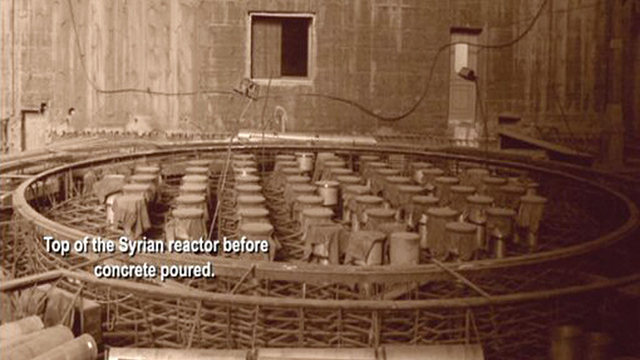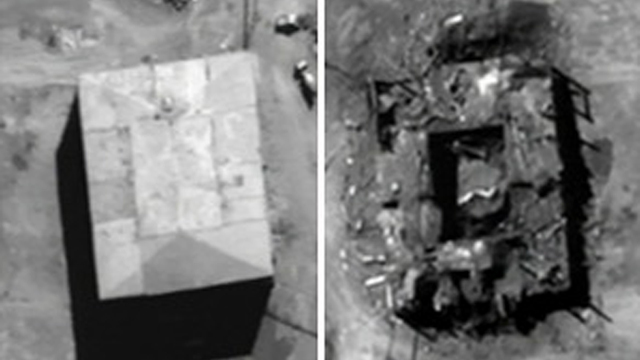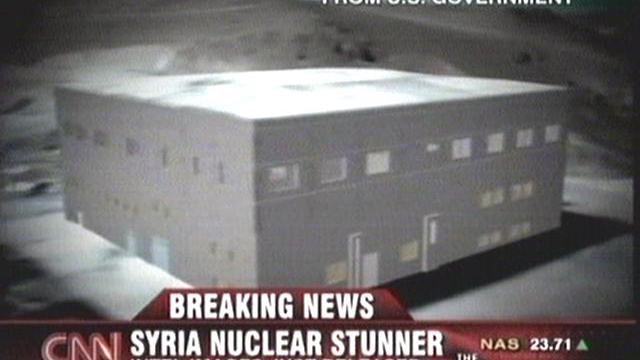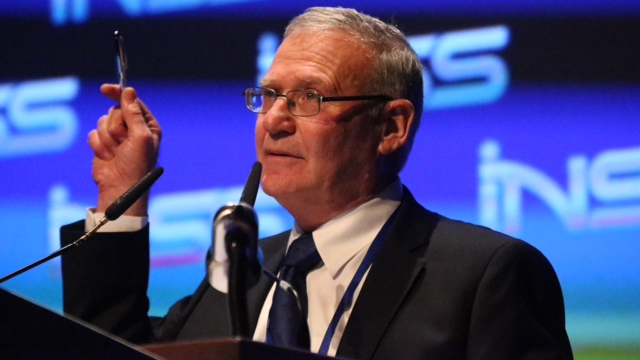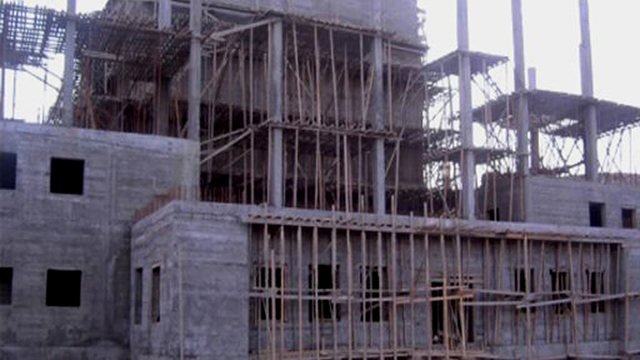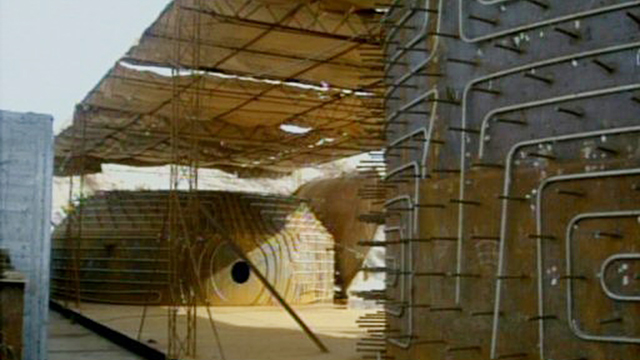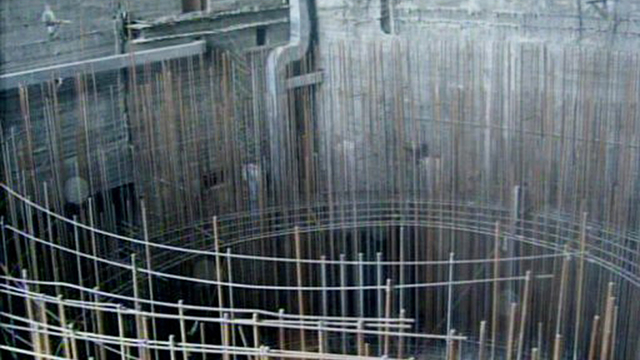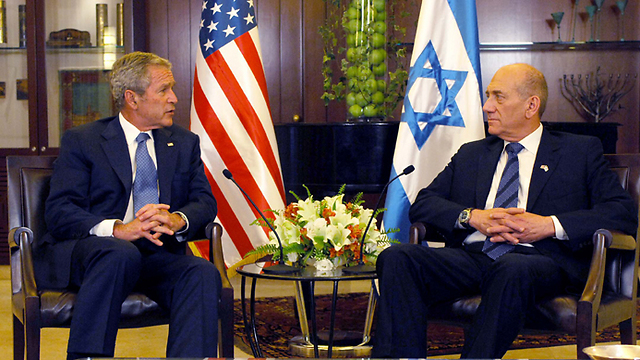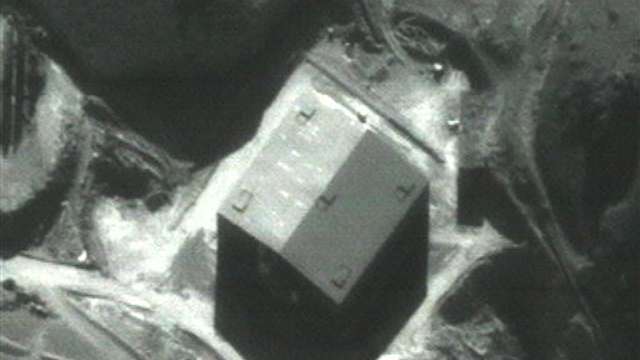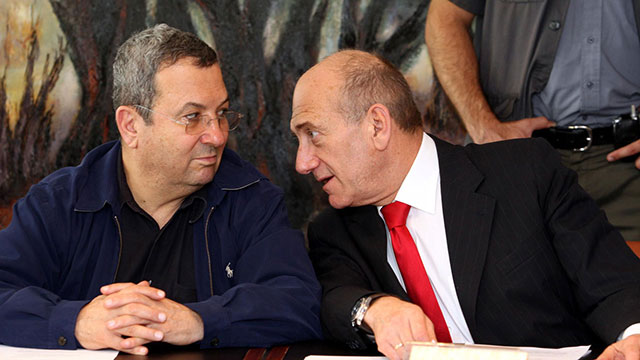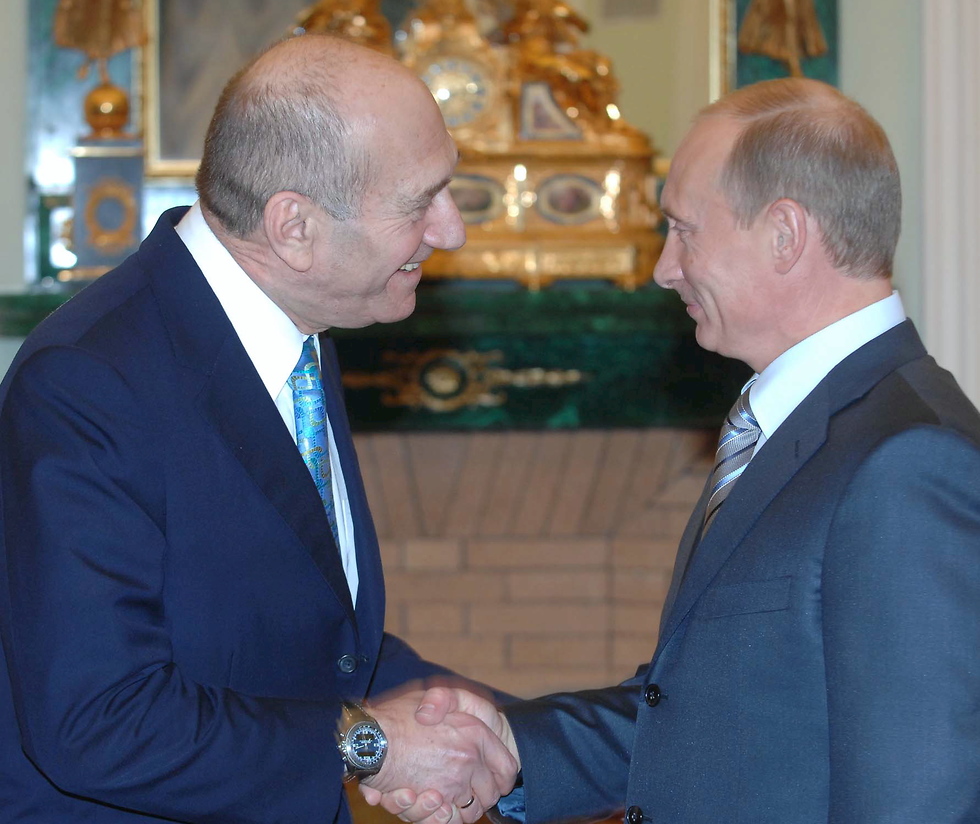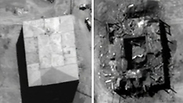

Israel confirms attacking Syrian nuclear reactor in 2007
After verifying the information the Mossad received in 2006 about a nuclear reactor being built in the Deir ez-Zor area with North Korea’s help, Israel decided to take action: Despite disagreements within the political echelon, warnings from the security services and futile attempts to get the Americans on board, the operation was completed within six months; now, 10 years later, the details of the strike that likely changed the face of the region have finally been cleared for publication.
On the night between September 5 and 6, 2007, Prime Minister Ehud Olmert arrived at the Israel Air Force “pit” at the Kirya IDF headquarters in Tel Aviv. Next to him sat his relatively new defense minister, Ehud Barak, Foreign Minister Tzipi Livni and representatives of the different security services.
Shortly before midnight, four F-15 and four F-16 aircraft took off from the Ramat David Airbase in northern Israel. The target marked on their computers was an isolated square-shaped building in a desert in northeastern Syria. They flew north along the Mediterranean Sea and then turned east on the borderline between Syria and Turkey.
Interviews: Attila Somfalvi, Yoav Zitun, Ron Ben-Yishai; Content editor: Noam Gil; Director: Assaf Cuzin; Camera: Yaron Sharon, Ori Davidovitch, Yogev Attias; Script, video editing, animation: Tamar Avraham; Production: Adi Berman; Content management: Noa Glickstein Keren.
Between 12:40am and 12:53am, the pilots repeated the codename, Arizona, before 24 tons of ammunition was dropped on Al-Kibar, a nuclear reactor that was secretly built by Syrian President Bashar Assad in the Deir ez-Zor area with North Korea’s help and guidance. The reactor was destroyed. All pilots returned safely. The Syrian nuclear program was eliminated. The Middle East, and perhaps the entire world, are breathing a retroactive sigh of relief today.
In the decade that has passed since then, Israel persistently refused to take official responsibility for the operation, until the Israeli Military Censor decided this week to clear it for publication. It was (yet another) classic case of the elusive ambiguity Israel specializes in when it comes to security-related issues: Making no declarations and taking no responsibility, but occasionally throwing some hints into the air.
Shortly after the strike, the Defense Ministry held a particularly festive and joyous toast ahead of the Jewish New Year in the presence of Olmert, Barak and Chief of Staff Gabi Ashkenazi; then-Opposition Chairman Benjamin Netanyahu said in a Channel 1 interview—intentionally or in a slip of the tongue—that he had been briefed on the successful attack; and a month after the reactor was destroyed, it was cleared for publication that Israel had struck in Syria, yet the target remained vague.
But the international press, and American officials who obviously are not subject to the Israeli censorship, failed to exercise the same restraint Jerusalem had sentenced itself to. In April 2008, US intelligence officials had already briefed Congress on their part in the Israeli attack on the reactor, and several sources in George W. Bush’s administration—including the president himself—addressed the affair in different ways in books they wrote and interviews they gave.
The Israeli news reports, therefore, had to be based on “foreign reports,” which included some detailed investigations and interviews in publications like The New Yorker magazine, Newsweek, the British Daily Telegraph and German weekly Der Spiegel. These reports presented a clear picture of the moves that had preceded the attack and the operation itself.
In one report, it was called Operation Orchard, and in another, Operation Arizona; in one report the Mossad’s preliminary intelligence activity was carried out in Austria, and in another report it was carried out in London; one report said the attack had involved eight planes, and another report said 10—but the overall picture was pretty clear, although the government never confirmed the reports or took responsibility for the attack.
It was critical for Israel to avoid a public announcement that it was responsible for the destruction of the reactor in Deir ez-Zor. A decade after the operation, this scenario may seem detached and unrealistic, but at the time there was real concern in the political echelon and in the defense establishment that the operation would prompt a Syrian retaliation that would lead to a regional conflict and to all-out war. Israel wanted to reduce motivation for retaliation as much as possible, and it was led by the assumption that the smaller the reverberations created by the strike, the lower the chance Assad would act.
The Syrian president was caught in a dilemma, as his failure to report the construction of the reactor was a violation of his commitment to the International Atomic Energy Agency (IAEA). The Israeli assessment was that to avoid further international trouble, not to mention the humiliation in having his nuclear ambitions shattered in an Israeli strike, Assad would prefer to bury the issue. If Israel avoided boasting about the attack in public, it would allow Assad plausible deniability and prevent a retaliation, which is why all the different security organizations—with Foreign Minister Livni’s enthusiastic support—were in favor of a “low-signature” operation.
Assad’s actual reaction was confused. First, he responded in complete denial (“Israeli Air Force planes infiltrated Syria’s airspace and were driven away”). Then, he claimed the target of the strike was a deserted military camp. Finally, he issued a weak threat that he reserved the right to retaliate, though not necessarily in a “bomb for bomb” manner.
Ten years have passed, and there has been no Syrian response. Over this time period, Israel has actually been the one to operate in Syria time and again—officially or according to foreign reports. It began with the assassination of Hezbollah’s chief of staff Imad Mughniyeh in Damascus, and continued—since the start of the civil war—with attacks on Lebanon-bound arms convoys and depots, responses to the spillover of mortar shells, and strikes against the military presence of Iran and Hezbollah in the Golan Heights, as well as the assassination of Jihad Mughniyeh, Imad’s son.
The destruction of the reactor by Israel turned out to have a dramatic impact on the region’s future. The changes Syria has been going through over the past six years raise alarming questions on what could have happened had Assad completed his plan under the international community’s nose and had nuclear abilities today. Equally alarming is the possibility that the reactor could have fallen into the hands of one of the radical Islamic groups fighting the regime. Maj.-Gen. (res.) Amos Yadlin, who served as Military Intelligence chief at the time of the operation, said recently that the strike prevented “a Middle East no one would have wanted to live in.”
The Al-Kibar reactor was destroyed as a result of a series of intelligence, diplomatic, political and military moves over the course of many tense months in the years 2006 and 2007. They took place in the Syrian desert, in the Mossad offices in Israel, in the White House, in the Prime Minister’s Residence in Jerusalem and in the Air Force headquarters, and according to foreign reports, in hotels in European capitals as well. Now, these moves have been cleared for publication.
The information that left little room for doubt
In the years leading up to the strike, the United States and Israel became concerned about Bashar Assad's nuclear ambitions. His father, former President Hafez Assad, had tried to buy nuclear research reactors from Argentina and Russia in the 1990s, but those attempts were thwarted by American pressure.
Towards the end of 2006, Israel began receiving information about a possible resumption of nuclear-related activity in Syria. According to then-Military Intelligence chief Yadlin and senior Mossad officials at the time, that was also when initial reports about a suspicious, mysterious building being renovated in a desert in northeastern Syria started arriving.
The building in Deir ez-Zor was constructed around 2002, and the North Korean activity aimed at turning it into a nuclear reactor began in 2004. The assumption in retrospect was that in order to disguise it, the Syrians tried to develop the nuclear abilities through centrifuges rather than a big reactor.
The covert project, which was developing right under the noses of Israeli and American satellites, was secretly conducted by Assad and a limited group of his associates, a fact Israel made good use of later on. According to Yedioth Ahronoth journalist Ronen Bergman, the people involved in the project contacted each other through sealed envelopes transferred by messengers to prevent the possibility of exposure through computers or the internet.
But information the Mossad received in 2006 left little room for doubt: About 10 images from inside the building indicated it was a nuclear plutonium reactor. It was located far from any large community, less than 1 kilometer from the Euphrates River, mid-way between the Iranian and Turkish borders. The pictures showed North Korean workers, and to the Israeli intelligence officials the facilities appeared identical to the unique Yongbyon nuclear reactor, which had been built by North Korea in previous decades.
Foreign media reports painted a picture that official Israel never confirmed or took responsibility for: The raw information was verified by the kind of espionage operation that sparks one’s imagination and inspires spy movies.
In early March 2007, it was reported, Syria's atomic energy agency director Ibrahim Othman participated in an IAEA meeting in Vienna, Austria. On one of the days of the conference, he left the apartment he had been staying in for a while and, for an unknown reason, left his personal computer behind. According to The New Yorker, Mossad spies infiltrated the apartment, copied the material found on the laptop, installed a software providing them with remote access to the computer, and took off. Israel has yet to officially confirm that such an operation actually took place.
Several days later, then-Mossad chief Meir Dagan presented the findings to Prime Minister Olmert. Olmert vaguely addressed that “piece of information” that had been placed on his desk at a later occasion: “From that moment, I knew nothing would be the same again. The meaning, on the existential level, was unprecedented.”
Olmert began running the Begin Doctrine in his mind—a basic assumption enunciated by former Prime Minister Menachem Begin when he decided to attack the Osirak nuclear reactor in Iraq in 1981, that Israel would not allow an enemy state interested in its destruction to attain nuclear abilities.
Olmert made a decision almost immediately: Israel would attack the facility as soon as possible, before the reactor becomes “hot” and its radiation pollutes the region and the Euphrates River. The operation was about to kick off.
American hesitation
Those days, Olmert suffered a drop in popularity in the wake of the Second Lebanon War. In an attempt to reach a diplomatic breakthrough, he held talks with Arab and Muslim leaders in the months that preceded the discovery of the reactor.
According to The New Yorker, in February 2007 he met with then-Turkish Prime Minister Recep Tayyip Erdogan in Ankara and asked him to explore whether Assad would be willing to launch secret talks with Israel. But the Syrian president’s positive response arrived only two months later, after the findings about the reactor had already been presented to Olmert and the discussions on a strike had begun.
Olmert began consulting and briefing former prime ministers—Shimon Peres before he was appointed president, Barak before he entered the coalition, and opposition leader Netanyahu. After the information was obtained, Olmert’s discussions on the matter were moved from the supposedly exposed “aquarium” at the Prime Minister’s Office to the Prime Minister’s Residence on Jerusalem’s Balfour Street.
Every Friday, he would meet with then-Defense Minister Amir Peretz (the strike was carried out after Peretz had resigned and had been replaced by Barak), Mossad chief Dagan, Shin Bet Director Yuval Diskin, Chief of Staff Ashkenazi and Military Intelligence chief Yadlin. The people involved were asked to sign non-disclosure agreements.
The decision to attack had been made, but it was unclear at the time who would take part in the strike or execute it. In mid-April, it was decided to update the US and inquire whether it would carry out the strike or take part in it. Defense Minister Peretz personally briefed Defense Secretary Robert Gates, who was visiting Israel.
At the same time, Dagan was sent to Washington with two of Olmert’s assistants—Yoram Turbowicz and Shalom Turgeman—to update CIA Director Michael Hayden, Vice President Richard Cheney and National Security Advisor Stephen Hadley. Dagan showed them the images from the reactor and watched their astonished faces.
President Bush instructed his people to verify the credibility of Israel’s claims. Still fresh in his mind was the embarrassment after no weapons of mass destruction were found in Iraq, despite his administration’s repeated claims to the contrary. The CIA appointed a special team to look into the matter, and the pictures were compared to satellite images of the Syrian facility and examined by the National Geospatial-Intelligence Agency and by nuclear experts. The CIA team determined that the Israeli intelligence was accurate. “If it’s not a nuclear reactor,” an American source said, “it’s an imitation of a nuclear reactor.”
Nevertheless, the Americans were still undecided on whether and how to act. Considering a diplomatic move, National Security Advisor Hadley convened a committee that included his deputy, Elliott Abrams; James Jeffery, an expert on Middle Eastern affairs at the State Department; and Eric Edelman, Gates’ assistant and a former US ambassador to Turkey. The content of their meetings was not revealed to anyone, the emails they exchanged remained confidential, and they were forbidden from taking any documents out of the White House Situation Room.
Some of the committee members were skeptical about the success of a possible diplomatic move, asserting that Assad would try to buy time for the reactor to go hot. They had no interest, however, in the US being actively involved in a military operation. On several Tuesday afternoons, Hadley convened an even more senior forum, which wasn’t in favor of an American military operation either. “Every administration gets one preemptive war against a Muslim country, and this administration had already done one,” Gates said bitterly.
One of the reasons the Americans were afraid of a military operation was their polite uncertainty regarding the IDF’s abilities, in light of the Second Lebanon War, but there were two other main reasons. The first had to do with the American public opinion, which was partly fed up with the military intervention in the Middle East, and the other had to do with two international initiatives led by Secretary of State Condoleezza Rice, and which might have been thwarted by an attack on the Syrian reactor: The world powers’ talks with North Korea about its nuclear project, and a Middle East peace conference that would be held in Annapolis.
‘If you don’t strike, we will’
On June 19, 2007, Olmert paid Bush a visit to discuss the Syrian reactor. Two days earlier, the American president convened a meeting with his aides. According to the Washington Post, Hayden informed him that the reactor in the Syrian desert was indeed part of a nuclear program (“we could conceive of no alternative uses for the facility,” he told him), but that since no other components of the program—like enrichment facilities—had been found, the Israeli findings should still be treated with “low confidence.”
While the administration conceded that the reactor could go hot in the coming months, Bush felt that the lack of unequivocal findings denied him the public and political justification for an operation thousands of miles away from home. In their June 19 meeting, Olmert tried to convince Bush to have the US lead the attack on the reactor, arguing that such a move would kill two birds with one stone: It would allow the Americans to remind the world of Assad’s evil regime and would convey a message dissuading Iran from pursuing its own nuclear program. He made it clear to Bush that if the US wouldn’t attack, Israel would.
In his memoir, Bush wrote that he had told Olmert he couldn’t launch an attack on a sovereign state unless his intelligence organizations made it clear to him that there was a nuclear weapon involved. But in that meeting, he promised Olmert an answer shortly.
On July 13, the American president called the Israeli prime minister and told him that if the US wanted to bomb the reactor, the administration would have to explain to Congress that the intelligence had come from Israel. Olmert, who was committed to confidentiality, rejected that option. Elliott Abrams later revealed in an interview to Amnon Levy on Channel 10 that Olmert had replied: “If you don’t bomb, we will. That’s all I’m going to tell you. You don’t want to know how or when.”
Bush wrote in his memoir that Olmert had been disappointed by the US preference for diplomacy. He quoted Olmert as saying, “(A nuclear facility in an enemy state) is something that hits at the very serious nerves of this country.” Over the years, Israel had watched the US foot-dragging in its nuclear-prevention policy towards North Korea and Pakistan with disappointment and misgivings (“too early, too early—oops—too late”). Diplomatic moves would have made Assad realize he had been caught, and then nothing would have stopped him from deploying anti-aircraft weaponry near the reactor or even place a kindergarten nearby.
Olmert was worried that now that the US had made it clear it would not take part in the military operation, any American official who was not on board with the Israeli strike might try to sabotage it by leaking information. He expressed his concerns to Bush, who gave up the diplomatic option and promised Olmert that the American side would remain silent. He didn’t give Olmert a red light, and Olmert saw that as a green light.
The American journalist who triggered the strike
Israel began preparing for the attack on its own. The IAF considered a number of possible strategies, and the alternative of a pinpoint airstrike was eventually chosen.
That month, Barak replaced Peretz as defense minister, after the latter had lost the Labor Party leadership. Barak was the only person involved in the secret preparations who expressed doubts about the urgency of the operation. Officially, he said he had feared a Syrian retaliation and another war in the north, but behind the scenes, his opponents argued, he had hoped the Winograd Commission’s report on the Second Lebanon War would weaken Olmert and lead to his resignation, and then Barak would be the one to lead the operation.
Addressing the claims that he had been driven by personal interests and his serious dispute with Olmert, Barak told Ynet recently: “These are just made up fabrications. In hindsight, perhaps some of the tensions may have developed as a result of the gap between Olmert’s urgent handling of the affair and the planned slower pace that I had demanded. After all, I have been planning and leading operations for years. I am very familiar with this area and I know how one should operate in it. I used to say at the beginning of every meeting, ‘This reactor must be destroyed.’ It was clear to me that there would be attempts to manipulate these things. I didn’t like the apocalyptic discussion of ‘who knows what will happen.’”
Who was it led by?
“It usually comes from prime ministers. It came from Olmert at the time.”

Barak’s fear of an all-out war in the north wasn’t baseless. Ahead of the operation to destroy the reactor, the IDF began preparing for a war with Syria. In the summer of 2007, the ground forces conducted exercises and carrying out preparations only in battalions and brigades, so as not to raise suspicions in Damascus. Only few senior officers were aware of the real reason for the preparations.
In early September, however, the cabinet realized it had to act quickly. According to a senior intelligence official, an American journalist had submitted a question to the spokesperson of the Israeli Embassy in Washington: Was Israel aware of a nuclear reactor for military purposes being built by Syria on its territory?
Even if the cabinet had considered postponing the operation, that option was no longer relevant at that point. Such a media report would reveal to Assad that he had been exposed and prompt him to act. On September 5, the Security Cabinet deliberated for the last time and voted to grant Olmert, Barak, and Livni sole power to approve the military approach and the timing of the strike. Just before midnight that day, the warplanes took off and headed to Syria.

Shortly after the planes returned to Israel, Olmert contacted President Bush, who was visiting Australia that week, and said to him: “I just want to report to you that something that existed doesn’t exist anymore. It was done with complete success.”
The first satellite image that arrived at the Kirya “pit” the following morning revealed what had been hiding under the square-shaped building: The reactor was destroyed and split in half, in a way that would make it impossible to put it to use again.
Uranium residues in the ground
The next day, the official Syrian news agency reported that Israeli planes had infiltrated the country’s airspace but were driven away, after dropping ammunition in a desert area without causing any injuries or damage.
Three weeks later, Assad gave an interview to the BBC and said that Israeli warplanes had attacked an unused military building and that Damascus reserved “the right to retaliate.” Syrian Ambassador the United Nations Bashar Ja’afari insisted that nothing had been bombed in Syria and that Israeli planes “were encountered by our air defense fire” and were forced to drop their ammunition and fuel tanks.
Israel helped Assad ensure his plausible deniability and sought to refrain from making any public statements on the matter. Olmert himself flew to Moscow to brief Vladimir Putin, who already had close ties with Assad back then.
The US nearly exposed Israel as the country behind the reactor’s destruction after all, when Vice President Cheney, who was eager to present North Korea’s role in Assad's nuclear project to the world, argued for disclosure. But Condoleezza Rice, keen to preserve the world powers’ diplomatic talks with Pyongyang, urged him to honor Olmert’s request for silence.
The denial game on both sides lasted many more months. Assad rejected repeated IAEA requests to visit the bombed site, before giving a limited group of international observers access to the place in June 2008. They found traces of radioactive material there, but Syria claimed those were traces of the Israeli strike. Another year passed before an IAEA investigation officially concluded that the site bore features resembling a nuclear reactor.
In 2013, the Al-Jazeera network published what it purported to be documentation from the site of the facility after it was conquered from the Assad regime by the Free Syrian Army (rebels considered relatively moderate). According to the report, they found no traces pointing to the existence of a nuclear facility, but did find long-range Scud missiles there.
Since then, the area has exchanged quite a few hands between the different forces and organizations fighting each other as part of the Syrian civil war. Three of these forces have been involved in battles around the site in recent months: The Assad regime’s army, the Islamic State (ISIS) organization and the Kurdish-led Syrian Democratic Forces, which are backed by the US.
The Syrian Observatory for Human Rights reported recently that forces of the military council of Deir ez-Zor had succeeded, in cooperation with
Kurdish forces, in taking over the village of al-Khobar Jazira, not far from the reactor. Since then, however, the Assad army has managed to regain possession of considerable parts of the Deir ez-Zor area, which had been held primarily by ISIS before its collapse began. A decade after the reactor was destroyed, that operation appears more relevant than ever.














